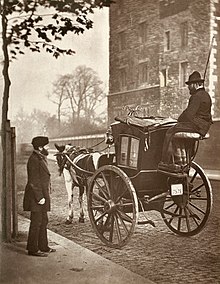Hansom cab
This article needs additional citations for verification. (August 2010) |



The hansom cab is a kind of horse-drawn
Cab is a shortening of
Hansom cabs enjoyed immense popularity as they were fast, light enough to be pulled by a single horse (making the journey cheaper than travelling in a larger four-wheel coach) and were agile enough to steer around
Design

The cab, a type of
Its main features were low-slung bodywork, high wheels and a rearward driving seat — the latter not at first evident. The purpose of its design was to combine speed with safety, having a low centre of gravity, essential for safe cornering and overtaking. Wheels were originally 7'6" in diameter, later becoming much smaller although still large in proportion. The dashboard was curved at the rear of the shafts, bringing the hind-quarters of the horse fairly near the vehicle, for better control. There would be room for two passengers facing forward, on a single cross-seat, their legs protected by knee flaps.[1]: 30
Other vehicles similar to the Hansom cab include the American light trade cart for deliveries such as bread, the bow-fronted hansom which was fully enclosed and entered through a side door, and the Brougham Hansom which was entered from the rear and driven from a seat on the fore-part of the roof.[1]: 5, 23, 31
Hansom Cab Company

The Hansom Cab Company was established in May 1869 to provide transportation in New York City and Brooklyn. The business was located at 133 Water Street, Brooklyn; Duncan, Sherman & Company handled the books of subscription (initial offers of stock to capitalize a new company). The enterprise was organized by Ed W. Brandon who became its president. Two orders for a fleet of cabs were sent to carriage makers in New York City. Fares were to be charged either by distance or time: $0.30 for a single person per mile, or portion thereof, and $0.40 for two people. By time, $0.75 for one person for an hour or portion thereof, $1.00 for two persons.[5]
United Kingdom

Two
The cabs were widely used in the United Kingdom until 1908 when Taximeter Cars (petrol cabs) started to be introduced and were rapidly accepted; by the early 1920s horse-drawn cabs had largely been superseded by motor vehicles. The last licence for a horse-drawn cab in London was relinquished in 1947.[7]
Museums
A restored hansom cab once owned by
In popular culture

- In Black Beauty by Anna Sewell, the central section has an evocative account of life as a Hansom cab driver in Victorian London, even though it is written from the point of view of the horse.
- "The Suicide Clubcycle (1878). Retired British soldier Lieutenant Brackenbury Rich is beckoned into the back of an elegantly appointed hansom by a mysterious cabman who whisks him off to a party.
- In 1886, Fergus Hume published his novel The Mystery of a Hansom Cab, set in post-Gold Rush era Melbourne, Australia. The story was filmed in Australia in 1911, under the same title. A movie was made for TV in 2012.[10]
- The 1889 film Leisurely Pedestrians, Open Topped Buses and Hansom Cabs with Trotting Horses, photographed by William Friese-Greene, shows Londoners walking along Apsley Gate, Hyde Park, with horse-drawn conveyances passing by.
- The book Farewell Victoria (1933) by T. H. White has the protagonist ending his days as a hansom cab operator in its fading years, which is part of the sustained metaphor brought out in the title.
See also
References
- ^ OL 11597864M.
- ^ "The Hansom Cab was designed, patented and tested in Hinckley". Hinckley Past & Present.
- OL 24585797M.
- ^ "The life of Joseph Aloysius Hansom (1803-1882)". Hinckley Past & Present.
- Newspaperarchive.com.
- ^ OL 3828623M.
- OCLC 841903541.
- ^ "Remington Carriage Museum website". Remingtoncarriagemuseum.com. Archived from the original on January 28, 2010. Retrieved August 23, 2014.
- ^ "Correspondence between the Sherlock Holmes Museum and James Purnell MP, The Secretary of State for Culture Media and Sport". Sherlock Holmes Museum. Archived from the original on March 6, 2008.
- OL 21631914M – via Project Gutenberg.
Further reading
- Berkebile, Donald H. (1979). Carriage Terminology: An Historical Dictionary. ISBN 0874741661.
- "Livery Driven Vehicles – Coson Carriage Tour". Carriage Association of America.
External links
- America on the Move | Hansom Cab. National Museum of American History, Smithsonian Institution.
- "The Hansom Cab of the Sherlock Holmes Museum, London". Sherlock Holmes International Society. Archived from the original on June 30, 2020.
- Hansom Cabs Sherlock Peoria.
- King, Laurie R. (1995). "A Monstrous Regiment of Women excerpt" (PDF). Archived from the original (PDF) on April 24, 2013. Retrieved September 14, 2012.Official website for Laurie R. King; features a cab-driving scene.
- Joseph Aloysius Hansom (History of York)
